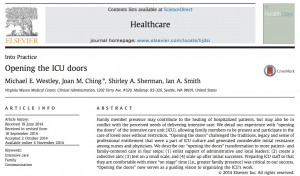Cross-posted from my personal blog yesterday
On Twitter Friday night I learned from Dr. Sachin Jain of a November article that should be of interest to all of us who want to work toward full patient and family engagement in all aspects of medicine. To be sure, the changes we’d like are not always simple, and one example is expanding family access to the ICU.
Virginia Mason Medical Center (VMMC) is widely known for being far far more patient-centered and quality-oriented than most medical institutions – including, in this case, even the really challenging parts. I hope I don’t get in copyright trouble for pasting too much in here, but the whole article is Open Access (no charge) so have a look, under the heading “Problem: Despite tradition, genuine need to open doors”:
Over time we became more aware that this traditional model was badly disconnected from the needs of our patients. The Institute of Medicine emphasized that families serve as a healing influence by providing comfort, connectedness, energy, self-esteem and wisdom; there is little or no evidence to indicate that the practice of family member presence is detrimental to the patient, the family or the health care team. Indeed family member presence during invasive procedures or resuscitation should be offered as an option to appropriate family members.
Wow. If you’ve ever tried to break through to see a relative in hospital when the staff says it’s their time and you should come back tomorrow, you’ll know what I mean when I say wow. That’s a real commitment to better care – and to the evidence and expert opinion, even when it’s not easy.
The abstract at start of article includes this summary of the process they developed:
(1) enlist support of administrative and local leaders;
(2) create a collective aim;
(3) test on a small scale, and
(4) scale up after initial successes.
Preparing ICU staff so that they are comfortable with more “on stage” time (i.e., greater family presence) was critical to our success. “Opening the doors” now serves as a guiding vision to organizing the ICU’s work.”
The article continues with how they made the change and a summary of what they learned, even including sample scripts for how staff actually says to family members. (Talk about “thank you for sharing”…) And this, in the conclusion:
Today the doors to our ICU remain open to family members, and the old, red sign has been replaced with welcoming information. “Opening the doors” has helped to minimize the barriers that physically separated patients and their loved ones, impeded access to regular exchanges of information, and interfered with decisionmaking. Our experiences add to an evolving standard of practice focused on the needs of families of ICU patients such hat the ICU’s “unit of care” has become both patient and family.
You yourself may want to share this paper with people. If you work in a hospital, it would be in your workplace. If you’re a patient or family member, you might even want to raise this with your local hospital long before you actually need it.







Recent Comments